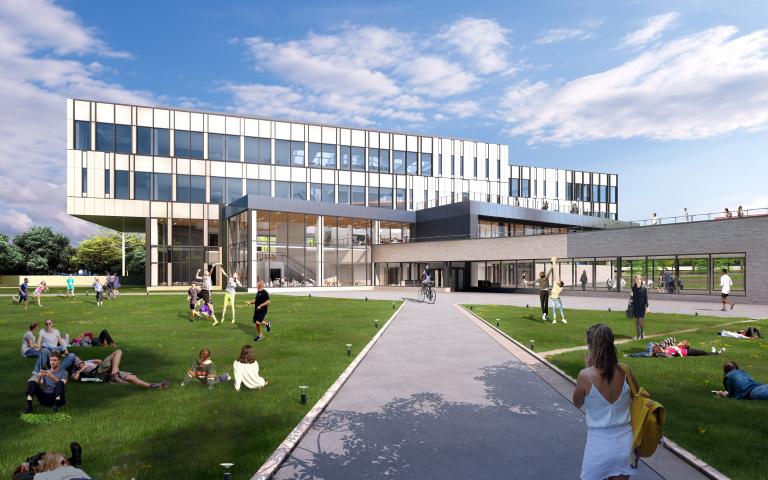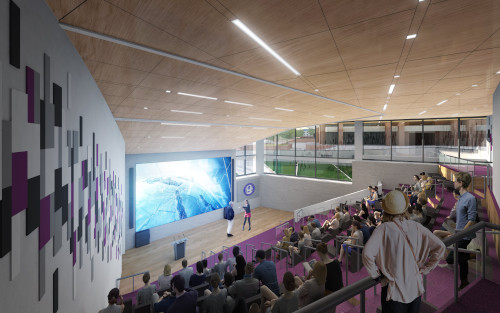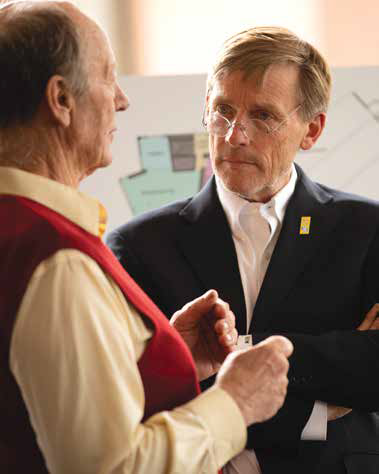
“This building is going to truly revolutionize this campus. It’s the kind of place where you can go and you can gather and you can stay. It will be the social and academic nexus of the campus.”
Kettering University’s learning model is unlike any other and produces experienced graduates prepared for challenging careers and lifetimes of success. This model has been in practice for 100 years. In a move further solidifying its international prominence as a STEM powerhouse, Kettering University unveiled plans for a new Learning Commons as part of its Boldly Forward Campaign. As the University celebrates its Centennial, it is fitting that it continues to evolve into its second century.
The Learning Commons Idea
In 2014, Kettering leadership presented a bold new Campus Master Plan, a vision for the University based on a detailed, multi-year study of the priorities and preferences of current and prospective Kettering students and the programmatic needs of the University’s faculty. It also includes studies of the market and the University’s physical assets. The Plan reimagines the Kettering campus in ways that ensure it will meet the needs of current and future generations and remain competitive in attracting talented students and faculty to the University. Specifically, the Plan calls for the creation of new core facilities that are critically needed to enhance learning, open new avenues for industry research and partnerships, create collaborative learning environments, and make the campus a focal point of opportunity for students, faculty, staff, and the Flint community.
It became clear that the first and most critical step in creating the future of Kettering University is the construction of the highest priority building under the Plan – the Learning Commons. The Learning Commons reflects the vision for the future of the University and responds directly to what has been learned about Kettering students. This hybrid-four-story building will support the kind of vibrant, campus-centered experience that is increasingly the expectation of current and prospective Kettering students. When built, the Learning Commons will become the living, beating heart of the campus.
“The Learning Commons is important for drawing new students, retaining students, and enhancing learning,” said Tom Ayers, Vice President for Administration and Finance. “It also proves to alumni and donors that they can collectively come together and do something of such magnitude. They’ve never been challenged to do something so bold.”
A Building for the 21st Century
The 105,000-square-foot, state-of-the-art Learning Commons will serve as the hub of faculty-student interactions, student-industry collaboration, flexible learning spaces, and the next century digital and physical library. Kettering is recognized internationally for its history of producing great leaders, and this distinctive new building will serve as a visual confirmation of Kettering’s commitment to remain a world leader on the technological stage – and, moreover, to lead that charge.
Prospective Kettering students are part of a generation that is freshly shaping the way learning happens in higher education. They are the first true technology natives; they have never known a world without computers, cell phones, and the Internet at their fingertips. They are engaged in hands-on learning and strong desire to collaborate with other students, their professors, and industry professionals. Their entrepreneurial spirits demand workplaces that are urban, flexible, collaborative, and functional – similar to the concept of the “office without walls.”
Longtime Kettering Co-op partner Magna International, headquartered in Troy, Mich., has committed support for the Learning Commons and a collaborative learning space (d.space zero) in the Campus Center. “At Magna we have an ongoing commitment to STEM education and helping students gain the skills and experiences they need to succeed in a challenging, dynamic future,” said Magna Chief Marketing Officer Jim Tobin. “We are proud to support the development of the new Learning Commons and to help encourage additional collaboration among Kettering students, faculty, and industry partners.”
 The techno-centric Learning Commons will feature flowing spaces infused with flexible, technology enabled gathering areas that foster small-group learning and interdisciplinary collaboration. Additionally, the building will include a “kiva” that offers multiple levels for gathering and presentation flexibility and a maker space with cutting-edge technology. Access points for information resources and a multi-level auditorium for large-group instruction, virtual dialogue, and broad sharing will take the Kettering experience to a new level.
The techno-centric Learning Commons will feature flowing spaces infused with flexible, technology enabled gathering areas that foster small-group learning and interdisciplinary collaboration. Additionally, the building will include a “kiva” that offers multiple levels for gathering and presentation flexibility and a maker space with cutting-edge technology. Access points for information resources and a multi-level auditorium for large-group instruction, virtual dialogue, and broad sharing will take the Kettering experience to a new level.
Nearly every space in the Learning Commons will feature a writing surface, allowing ideas to flow freely and inviting ad hoc study groups to form easily and seamlessly. Also included will be a student maker space with a focus on mobility and artificial intelligence, offering capabilities for projects from the classroom, industry, and co-op partners. In other words, the building will bring technology and creativity into one shared space, thereby creating a culture of collaboration across disciplines for the University and the community.
Taking a leap forward, the Learning Commons will showcase a full digital library, foregoing the conventional book stacks of a traditional academic library. With digital resources such as books and videos available through streaming services, the entire building will serve as a library for students, faculty, staff, and guests.
“Normally a library is a learning space people come to when they need information or to study and collaborate,” said Dr. Dina Mein, Kettering University Librarian. “The Learning Commons is that space with the walls blown off. The whole building is a learning space.” Library staff will walk through the building and engage with students as they need assistance or guidance.
“The reason we need the building is because of the collaborative and experiential learning that takes place here,” Mein said. “This new environment is conducive to teaching and learning. I can’t wait to see what our faculty and students do with it and how we can then help them on the journey.”
New food service venues and options will be featured in the Learning Commons. The building will offer a variety of options for students to grab a coffee and snacks or full meals. A guest suite will be included and designed to accommodate alumni and other campus guests, integrating them into the campus community for the entirety of their visit.
An attention to physical beauty through art, light, and windows will help engage the “right” brains of students and faculty, providing balance in their academic life. A walkway between the Campus Center and the Learning Commons will display pieces of art, much like in the University’s Arts and Humanities Center, and be prominently visible to students, faculty, staff, and visitors daily.
“You will walk into the building and get a creative lift,” Mein said. “The Learning Commons is a combination of the science of teaching and learning and the services needed for student success. It’s not the old way; it’s the new way. It breaks down barriers. It puts all the elements of successful instruction in one place for everyone.”
The University aims to break ground in spring 2020 and anticipates at least two years of construction.
“This building is going to truly revolutionize this campus,” said Kettering President Dr. Robert K. McMahan.
“It’s the kind of place where you can go and you can gather and you can stay. It will be the social and academic nexus of the campus.”
Moving Boldly Forward
The Learning Commons budget of $60 million is part of the Boldly Forward Campaign, which is making steady progress to reach its goal of $150 million by December 31, 2021. Philanthropic efforts are at an all-time high for the University, with strong engagement from alumni, corporate partners, foundations, and individuals.
 “This institution has never seen this level of giving, this level of generosity, and this level of commitment in terms of philanthropic support. It’s not just due to one person or two people, it’s due to all of us,” McMahan said. “This institution has not always had a culture of philanthropy because of its interesting background and history with General Motors. For an institution of our size to raise this amount of money so quickly sets us on a very, very clear and positive path in that direction.”
“This institution has never seen this level of giving, this level of generosity, and this level of commitment in terms of philanthropic support. It’s not just due to one person or two people, it’s due to all of us,” McMahan said. “This institution has not always had a culture of philanthropy because of its interesting background and history with General Motors. For an institution of our size to raise this amount of money so quickly sets us on a very, very clear and positive path in that direction.”
The Boldly Forward Campaign is the largest in Kettering’s history. The University’s Board of Trustees are in unanimous support of the Campaign and the Learning Commons, and they have expressed their commitment to it in their 100% personal financial participation, resulting in a collective gift of $7.7 million.
“There were critical needs the University had that could only be addressed with philanthropic resources,” said Gary Cowger, a member of the Board of Trustees and the Boldly Forward Committee Chair. “Kettering needed to undertake a significant campaign that would show what a difference we could make for this institution by coming together to share resources at new levels. This campaign had to be more than a campaign; it had to be a transformational initiative for this University.”
The Boldly Forward Campaign and the Learning Commons are, indeed, transformational ideas and Initiatives.
Susan L. Davies, Vice President of University Advancement and External Relations, explained, “The campaign is a way of bringing people together with a focused goal of positive change. People find reward in making a difference. When you change a student’s life, you positively impact their family, future children, communities, careers, and industries. That’s the joy of supporting higher education. At Kettering, we can actually see the impact. Gifts large and small come together to transform an institution and create a legacy.”